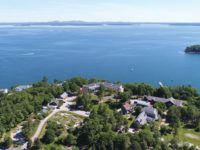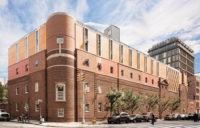Chicago
As many American architects know too well, public schools in the U.S. lose out big-time on the scale of invention compared to their European and Asian counterparts. With the tight budgets and detailed restrictions handed down by school authorities, it is the rare architect who can be both ingenious and pragmatic. Yet John Ronan Architects (with DeStefano + Partners as architect of record) show it is possible with the South Shore International College Prep High School in Chicago.
This is not a normal public high school: The Chicago Public Schools agency has made it part of a program that prepares students for college. A school administrator says half the students are admitted city-wide, while the other half are students from the neighborhood south of Jackson Park who meet minimum academic requirements. Role models from the past loom: Financial advisor Suze Orman, Oracle founder Larry Ellison, and Nobel Prize–winner James D. Watson all went to the old South Shore High.
In designing the 213,000-square-foot structure, Ronan worked with the Public Building Commission (PBC), in charge of planning, design, and construction of city facilities. Since the 1,200-student high school was included within an “urban model” prototype program to speed the building process and lower costs, he had to act fast. “We had nine months from the start of the design to the completion of the construction documents,” Ronan says. And the architecture had a tight budget of $70 million—or about $300 per square foot. The new high school was to express its role as an instrument of change by replacing a 1969 Brutalist concrete structure (designed by Fridstein & Fitch). While the older building had been regarded as innovative in its time, it had not aged well. (Interestingly, a 1940 Moderne brick building housing four specialized high schools next door remains in use.)
“The new building should instill a sense of pride in the students, yet be accessible to the community,” explains Ronan, who has already designed four other schools in the Chicago area—not to mention the elegantly rendered Poetry Foundation. His award-winning projects mine the early Modernist vocabulary of taut planes and clean lines which exploit space, light, and transparency. And like his Modernist forebears, Ronan creates spaces that serve multiple needs: the gym, for example, can be converted into a 1,200-seat auditorium; the library, pool, and gymnasium can be entered directly from the outside, so that the community can use the facilities when school is not in session.
For the three-story structure, Ronan developed a parti where he grouped spaces within three rectilinear volumes according to function: athletic activities in one; academic in another; and the library, arts, and music spaces in a third. These distinct volumes shift past each other on the 168,000-square-foot site to create semi-enclosed outdoor areas for the main entrance, an athletic space, and a reading garden. In addition, Ronan submerged the gym/auditorium and the swimming pool 10 feet below grade, where they still receive daylight from clerestories.
In response to the PBC's arresting mandate that the building be designed to last 100 years and rely heavily on masonry, Ronan clad the exterior walls of the steel-frame-and-concrete deck structure in a ground-face limestone block. (Red glazed clay tile covers the entry walls of the gym, blue tile designates the pool, and yellow tile the library.) Dark gray masonry alternates with lighter gray for major expanses, and the darker block acts as a thermal mass to store heat on sunny, cold days, slowly releasing it at night. Other green strategies meet the PBC's desire for a LEED-Silver building: Sedum roofs over the gym, pool, and library reduce the urban heat-island effect. Inside the building, a displacement system for the HVAC causes conditioned air to rise to returns at the top of the ceiling—a healthier and more efficient alternative to forced air.
Because occupancy is being phased in over four years, only ninth-graders (about 320 of them) currently attend the school. Still, interviews with two students reveal that they are worried about eventual overcrowding. One student says the gym is her favorite area because “it is so spacious,” adding, “the classrooms can be claustrophobic.” The classrooms, which are generally 30 feet by 30 feet, accommodate 30 pupils, which this student found to be a problem “when noisy students deprive you of focus.” Another student agrees, favoring the pool and the central hallway (“the best”) for their ample sizes. He also commends the design for its “nice look,” with the exception of the brown tile coating some interior walls. “It needs to be more cheerful,” he maintains. The young critic adds he would have preferred the tile to be blue and green—the school colors—“like these,” he says, proudly pointing to the vibrantly hued stripes of his school tie.
Total construction cost: $70 million
Size: 213,000 square feet
Completion date: January 2011
People
Owner/Client: *Erin Lavin Cabonargi, Executive Director
Design Architect:
Personnel in architect's firm who should receive special credit: Interior designer: John Ronan Architects Engineer(s): Rubinos & Mesia Engineers, Inc. (structural); Environmental Systems Design (MEP/FP); Prism Engineering (civil);
Consultant(s): Lighting: Charter Sills Pool: Innovative Aquatic Design, LLC Theater: Bill Conner Associates LLC Food Service: Edge Associates Inc. Cost Estimator: The Concord Group General contractor: Sollitt/Brown & Momen
Photographer(s): Renderer(s): John Ronan Architects CAD system, project management, or other software used: Autocad, 3D Studio, Indesign, Illustrator, Photoshop |
Products
Structural system
Exterior cladding Metal Panels: Centria Metal/glass curtain wall: Pittco Architectural Metals, Inc. ACM: Mitsubishi Alpolic Moisture barrier: W.R. Meadows Curtain wall: Pittco Architectural Metals, Inc. Other cladding unique to this project: Plaza pavers: Wausau Tile Permeable pavers: Advanced Pavement Technology
Roofing Green Roof: Green Grid Roofs
Windows Metal frame: Traco
Glazing
Doors Metal doors: Curries Wood doors: Graham Fire-control doors, security grilles: Cookson Company, Inc.
Hardware Closers: Dorma Exit devices: Dorma Pulls: Rockwood Security devices: Dorma
Interior finishes Suspension grid: Armstrong Paints and stains: Benjamin Moore, Sherwin Williams Plastic laminate: Formica Solid surfacing: Corian Floor and wall tile: McIntyre Tile (lobby), American Olean (bathroom walls) Glazed Block: Elgin Butler Company Resilient flooring: Armstrong, Johnsonite Carpet: Interface Terrazzo: Terroxy Resin Systems
Furnishings
Lighting Downlights: Lightolier, Ledalite Exterior: Kirlin
Conveyance
Plumbing Other unique products that contribute to sustainability: Modular green roof system. Permeable pavers at parking areas. |












